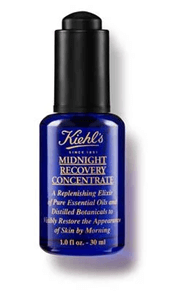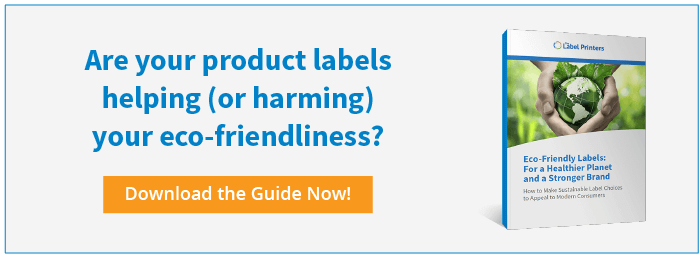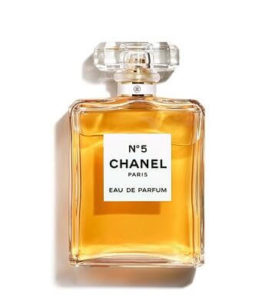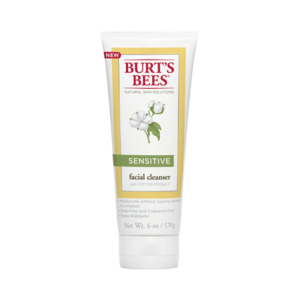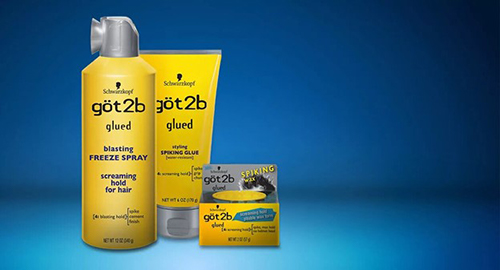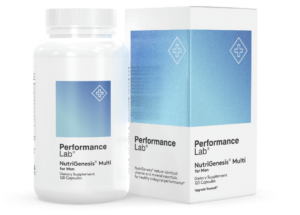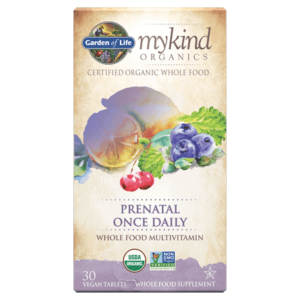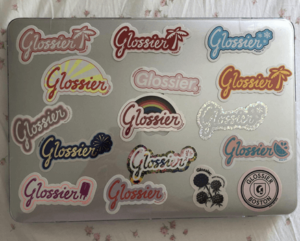
Custom Labels for Health and Personal Care Products
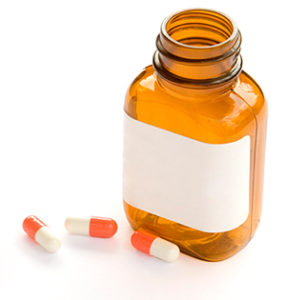 Imagine taking a pill from an unmarked bottle. Can you even conceive of slathering an unlabeled cream on your skin? The thought alone is unsettling.
Imagine taking a pill from an unmarked bottle. Can you even conceive of slathering an unlabeled cream on your skin? The thought alone is unsettling.
Healthcare labels (like those for over-the-counter medications and supplements) and personal care labels (like those for beauty and hygiene products) are all about imparting essential information that consumers rely on for peace of mind.
These labels need to convey the ingredients and instructions for use, yes, but also so much more. Consumers look to beauty product labels and healthcare labels for assurance that a brand shares their values and will help them achieve their goals for better health or a more vibrant appearance.
So as a health or personal care brand, a custom label is not a choice to take lightly. In this guide, we’ll explore general considerations to keep in mind when selecting health or personal care custom labels, as well as some of the specific use cases to consider.
To jump to a specific section, click on one of the links below.
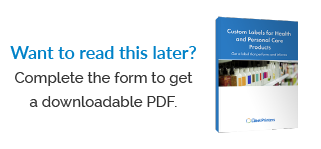
Part 1: Custom Labels for Health and Personal Care Brands: General Considerations
Factors brands should consider when creating their custom health and beauty product labels include
- The shape of the container
- Exposure to the environment
- Government regulations
The Shape of the Container
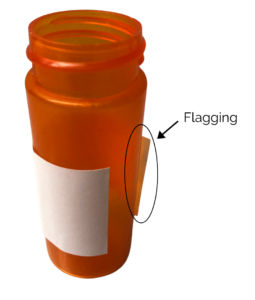 Health and beauty products come packaged in a range of container types: bottles, jars, boxes, bags, tubes – and the list goes on. Some products – artisanal soaps, for example – may not have much packaging at all. Each type of packaging has unique characteristics that must be accounted for in your choice of custom label.
Health and beauty products come packaged in a range of container types: bottles, jars, boxes, bags, tubes – and the list goes on. Some products – artisanal soaps, for example – may not have much packaging at all. Each type of packaging has unique characteristics that must be accounted for in your choice of custom label.
For example, anytime a label wraps around a cylindrical surface such as a jar or a bottle, flagging can occur. Flagging happens because labels naturally lie flat. When labels are wrapped around a curved surface, they tend to revert to their original position, resulting in the ends of the label becoming unstuck and sticking out like little flags. Flagging can also happen when labels are applied with insufficient or uneven pressure, which can occur during hand labeling or high-speed application.
There are two solutions to flagging:
- Choose material that resists flagging.
- Allow for overlap so the label can wrap around the curved container and stick to itself. Typically, an overlap of 1/16th of an inch is sufficient.
Tip: Keep the overlap zone clean and free of ink, varnish, or laminate to ensure the best possible surface for adhesion.
If you don’t already have a container for your health or personal care product, keep in mind that the more complex the shape, the more steps will be needed to ensure a smooth fit with your product label. If you choose to work with The Label Printers, you can send us the container for an accurate measurement to ensure optimum fit.
Exposure to the Surroundings
Health and personal care items experience some of the harshest surroundings that consumer products can encounter.
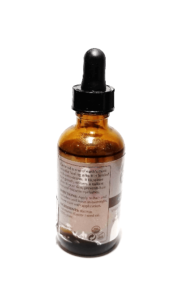
Paper label exposed to oil
These products can frequently be found in warm, steamy bathrooms, or even in the shower, where soaking in hot water may be an everyday occurrence. Vitamins and supplements are often stored in a cabinet over a hot stove or in a cold refrigerator. Other products, such as hand sanitizers, wipes, or cosmetics, may be jammed and jostled within purses or pockets and left out in the sun or in a sub-freezing car in the winter.
And that’s just the surroundings. The product itself can be hard on a label, particularly if certain oils or solvents are present in the product. For example, look at this bottle of castor oil from one of our team’s medicine cabinets. The oil has completely stained the label, making it hard to read and certainly not appealing to a consumer.
If you anticipate watery or oily surroundings for your health or personal care product, steer away from paper labels. Synthetic materials such as polyethylene and polypropylene repel water and are more durable than paper, making them better choices for wet, abrasive surroundings. In addition to their durability, some of these films conform better when applied to containers with challenging shapes.
Ink matters, too. We recommend oil-based inks since water-based ink will drip and run when exposed to moisture. A protective varnish or clear film laminate will also provide an additional layer of protection.
Tip: While you’re thinking about your product’s use-case environment, don’t overlook all the steps the product goes through to arrive at your customers’ homes. Your label must be able to hold up through the filling, labeling, packing, and shipping process. Your label printer can help with this, as well.
Government Regulations
Product labels don’t just keep your users safe; they also protect your company from lawsuits and fines. Cosmetics and pharmaceutical products face strict government regulations concerning the information that must be included on their labels and how the information must be formatted. The specific regulations with which you must comply vary depending on your product category.
For example, U.S. Food and Drug Administration (FDA) regulations require over-the-counter medications to include a Drug Facts label. A Drug Facts label “uses simple language and an easy-to-read format to help people compare and select OTC medicines and follow dosage instructions,” the FDA says.
To comply with FDA regulations, a Drug Facts label must present the following information in the following order:
- Active ingredients, including the amount in each dosage.
- The purpose of the product.
- Uses for the product.
- Specific warnings (such as when the product should not be used and when it should only be used under the guidance of a healthcare provider). This section also includes side effects.
- Dosage instructions.
- Inactive ingredients (so consumers can avoid ingredients that cause allergic reactions).
Here is an example of a Drug Facts label from the FDA’s website:
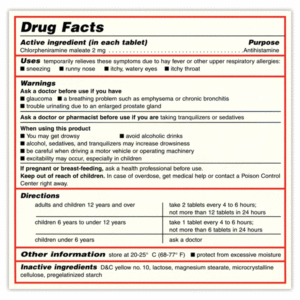
Cosmetic and personal care items have their own set of federal regulations to comply with.
The FDA’s requirements concerning cosmetics labels include:
- Cosmetics may not be misbranded. The labeling must be factual.
- The principal display panel must “state the name of the product, identify by descriptive name or illustration the nature or use of the product, and bear an accurate statement of the net quantity of contents of the cosmetic in the package in terms of weight, measure, numerical count, or a combination of numerical count and weight or measure.”
- The declaration of quantity must be distinct and placed along the bottom of the main display panel, generally parallel to the base of the container.
- The name and address of the company marketing the product must be stated.
- Cosmetics produced for retail sale must include a list of ingredients. The list must be conspicuous enough to be read at the time of purchase. The ingredients must be declared in descending order of predominance.
- Labels must bear appropriate hazard warnings and directions for safe use.
- Certain types of products (such as liquid oral hygiene products) must be packaged in tamper-resistant packaging.
These are just a few of the FDA regulations regarding cosmetics and personal care product labeling. We encourage you to read through the entire list here. Moreover, if your product is also intended to treat or prevent disease, it must also comply with drug labeling regulations. If you are unsure about any of these requirements, consult with an expert label printer.
What Is at Stake?
When health and beauty product labels fail by peeling off or becoming illegible, or when they run afoul of government regulations, they risk your company’s reputation and revenue, and they endanger your customers. The stakes are high.
Consider the case of the 26 cosmetic companies that faced a lawsuit for allegedly mislabeling their products as “organic.” The environmental group that sued the companies claimed the brands violated a California law requiring organic products to contain at least 70% organic ingredients.
The plaintiff claimed some of the products included ingredients known to cause cancer.
You don’t want your brand to end up featured in negative news articles and lawsuits. Make sure you understand your regulatory obligations and work with an experienced label printer to create a label that will perform amid the toughest conditions.
While it’s important to ensure your label will endure everything thrown at it, including regulatory requirements, it’s also important to consider what customers see – which brings us to your branding.
Part 2: Visual Branding Tips for Healthcare and Beauty Product Labels
A custom label is an essential element of your brand.
The health and personal care industry is extremely competitive. In almost every product category, consumers are confronted with dozens or even hundreds of choices on the shelves of drugstores, supermarkets, high-end cosmetic retailers, and specialty shops. More often than not, consumers make their decisions based on visual cues like the color of the packaging, striking imagery, or an eye-catching font.
When it comes to color, type, and imagery, demographics come into play. Some audiences appreciate designs that crackle with high-energy or amuse with irreverent humor. Others seek the comfort and reassurance of traditional design that evokes decades of quality. The first rule of branding: Know your buyers.
Here are some of the critical branding decisions you will have to make when designing a custom label for a healthcare or beauty product:
Color
Modern label printing technology now allows for a wider gamut of colors than ever before. Sophisticated label printers possess equipment that can combine the traditional CMYK inks (cyan, magenta, yellow, and black) with orange, violet, and green. The result is a color range that includes nearly a million different shades (versus 550,000 for CYMK alone), in addition to Pantone spot colors.
In the graph below, the extended CMYK+OGV gamut is represented by the larger transparent shape. (The individual dots represent Pantone spot colors.)

Whatever your specific brand colors are, there’s a good chance your label printer will be able to replicate them. If not, it’s time to talk tolerances and expectations.
Tip: Always share artwork with your label printer in a “native” file format such as Adobe Illustrator. Keep in mind the RGB color gamut used by your computer monitor is not the same as the CMYK format used in printing. For best results, use CMYK from start-to-finish throughout the label design process.
What Do Colors Say?
A single color can sometimes define a brand. Think, for example, of Tylenol’s iconic red or Noxema’s deep blue.
Brand colors can say a lot without a single word. Different colors resonate with various emotional and psychological meanings:
- Red can represent love, passion, and excitement – or anger, too.
- Purple is the color of creativity, wealth, and luxury.
- Green makes people feel relaxed and connected to health and nature.
- Yellow symbolizes “sunshine,” “fun,” and “laughter.”
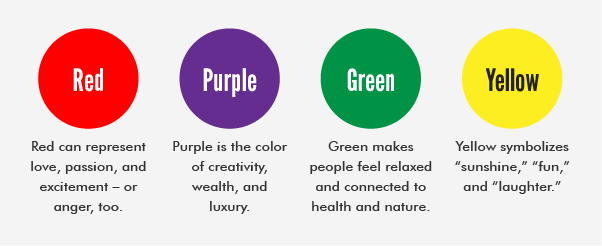
You may also decide to go with no color at all and let your packaging or your product speak for itself. Clear labels are an increasingly popular choice for health and personal care brands. Kiehl’s uses a clear label to good effect on this facial oil. No matter how much of the product gets on the label, it’ll always look like new. Besides, why cover up the striking cobalt blue bottle?
Typography and Written Copy
After color, typography may be the branding element consumers most associate with the products they love and trust. And like color, the style, shape, and size of a font send different messages to viewers.
For example, high-end brands tend to employ fonts that convey luxury, quality, and tradition. This is the case with the chic, minimalist typography that has graced bottles of Chanel No. 5 since the 1920s.
Interestingly, at the time, this label was seen as shockingly modern (most cosmetic and perfume labels in that era were very ornate). The lesson here: Don’t be afraid to ruffle a few feathers with a bold look – it may become your hallmark.
(Browse some of our favorite classic cosmetic labels here.)
When selecting a typeface, be sure to account for legibility. If your product is aimed at older people, you may not want to use a five-point font that is difficult to read. (Braille may also be a requirement in certain regions and a good idea if your customers include the visually impaired.)
If you have more information to share than can comfortably fit on your label, consider using an extended-content label. Extended-content labels fold out to provide additional space for text, coupons, usage instructions, ingredients, and any “bonus” content you want to share with your customers. Extended-content labels are also useful for meeting multiple language requirements.
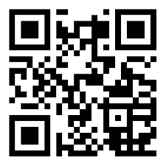 Another way to share additional information with customers is through QR codes. These two-dimensional barcodes are scannable with most smartphones and can link to your brand’s website, a video, or any other online location that extends the value of your brand.
Another way to share additional information with customers is through QR codes. These two-dimensional barcodes are scannable with most smartphones and can link to your brand’s website, a video, or any other online location that extends the value of your brand.
Many drug companies use these “smart labels” to link to helpful resources for managing a health condition, such as lists of beneficial foods, videos of helpful exercises, and Q&As with leading physicians.
Veritas Farms, which manufacturers CBD products, marks each of its products with a batch-specific QR code. The QR code links to testing data validating the purity and potency of the products.
Near-field communication (NFC) chips can serve a similar function to QR codes, with the added benefit of feeding marketing data back to your company.
Imagery
The imagery on your custom label is your brand’s chance to showcase its personality. You can choose from among any number of approaches: extravagant, minimalistic, traditional, irreverent, utilitarian, and so on. Or you can chart your own course.
Health and personal care packaging covers the entire spectrum when it comes to imagery, from the soft and natural look of Burt’s Bees (which emphasizes the salon brand’s environmentally friendly botanical ingredients) …
… to the wild-child aesthetic of göt2b.
Supplements, vitamins, and over-the-counter remedies display some of the most creative modern label design. Many supplement brands go with a scientific look, highlighting the research and testing that goes into their formulations. This approach is often minimalistic, such as the design for Performance Lab multivitamins:
Other supplement brands choose nature-inspired designs to underline the purity of their natural ingredients. We see this, for example, in Garden of Life supplements and vitamins, a brand whose logo is a cornucopia of wholesome fruits and vegetables.
Label Stock
Don’t overlook the sensation of touch. The material you choose for your label can send subtle signals to buyers about the characteristics of your products.
Natural-looking materials such as kraft paper or cardstock lend an aura of authenticity to handmade, artisanal items. High-end skincare and perfume brands can emphasize their luxury with creamy paper and thick cardstock. As long as your product isn’t oily and won’t be exposed to water, paper can be an elegant or charmingly natural choice.
Part 3: Other Considerations for Health and Personal Care Labels
Custom labels can serve all manner of purposes beyond product branding and identification-sharing. They can be used for coupons and special promotions, for instance.
Skincare brand Glossier packages all its orders with collectible stickers that change with the seasons and new product launches. The Glossier stickers encourage brand loyalty as shoppers strive to collect them all.
Labels also play a key role in shipping and mailing. This has become especially important as the COVID-19 pandemic triggered a massive shift toward e-commerce for businesses in nearly every field. Durability is a crucial factor in the construction of shipping labels. If labels peel off or become destroyed, packages carrying essential healthcare goods could fail to reach their destinations.
That is … if they’re not diverted to the gray market first.
Custom Labels and Brand Protection
Counterfeiting and unauthorized “gray market” sales are major problems in the health and cosmetics industries. Almost 20% of women aged 18-20 have mistakenly purchased counterfeit cosmetics online. Even more troubling, counterfeit medications (including OTC drugs) hurt and kill millions of people around the globe every year.
Custom labels can form the backbone of a brand protection strategy that can help your company take back control of its image and protect your customers from harm. (Learn more about brand protection in our multi-part series on the topic.)
The latest technological developments in brand protection employ labels to thwart counterfeiters, secure supply chains, and detect product tampering. Here are just a few of the ways custom labels can be used for brand protection:
- Making replication difficult through layering of overt security features such as holography, color-shifting ink, and serial numbers.
- Marking genuine products with covert features such as invisible ink, microprinting, and forensic chemical signatures.
- Enabling track-and-trace throughout the supply chain with RFID tags or barcodes.
For All Your Label Needs, Partner with a Label Expert
This guide covers a lot of ground. You may never before have thought about how much can go into planning and creating the perfect custom label for your health or personal care product.
But there’s no need to feel overwhelmed. The team of experts at the Label Printers has decades of experience helping top cosmetic, drug, beauty, and supplement brands solve the toughest label challenges.
Whether it’s matching your new brand colors, meeting a demanding schedule for a product rollout, testing label materials and adhesives under real-world conditions, or helping you keep your brand and customers safe with the latest brand protection technology, we’ve done it before, and we’re excited to do it for your company.

